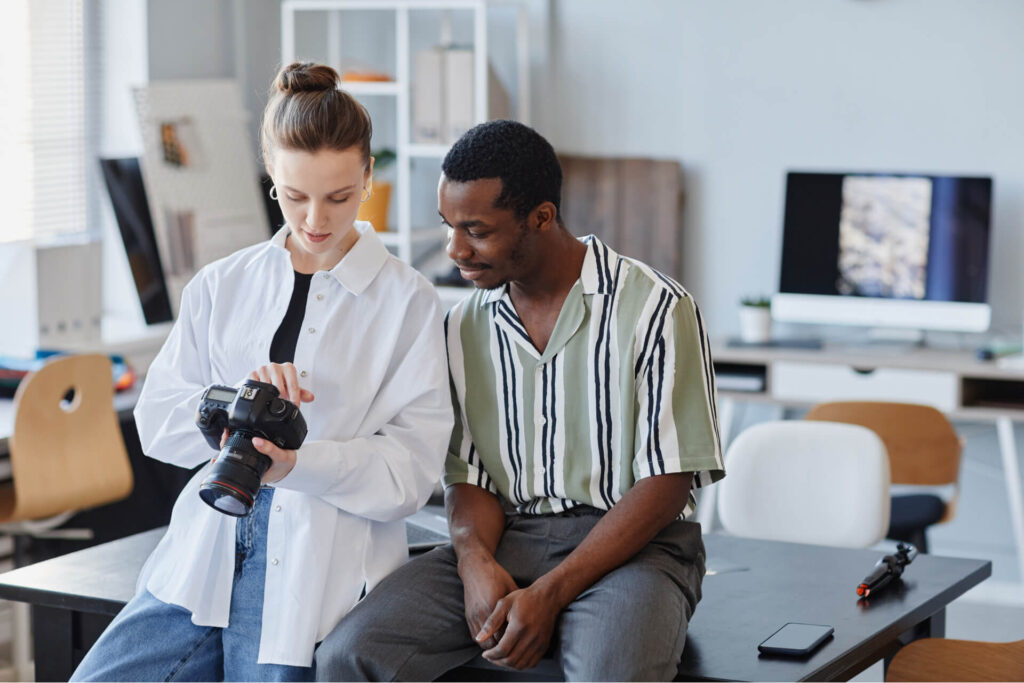Fashion photography is an art that challenges the concept of aesthetics while also serving as an inevitable medium for the commercial aspect. This is because fashion photography reveals clothing but also reiterates cultural narratives, social movements, and personal expressions. On the basis of this vision, this article will explore the different kinds of international photographers in the world of fashion photography and discuss their lifestyles, which influence their work styles, techniques, and problems.
What Are the Main Styles of Fashion Photography?
High Fashion Photography
High fashion photography is usually characterized by over-the-top styling, dramatic poses, and luxury brands. Generally, one would expect a quality magazine to be Vogue and Harper’s Bazaar. Famous photographers such as Steven Meisel and Mario Testino have typified this style. These photographers make images that command their way into the world of genius creativity. Generally, this kind of photography depicts amazingly well-designed sets and unusual themes and avant-garde ideas aimed at breaking open the common beauty paradigm.
Editorial Fashion Photography
Editorial fashion photography is stories in pictures, usually for the purpose of associating with articles in fashion magazines. This type of imagery and concept combines more of a narrative than simply clothing. Whimsy and fantasy photography, especially that done by photographers such as Tim Walker, allows the viewer to be transported to unseen worlds of only their imagination. This kind of style aims to elicit an emotional response from the view and thought-provoking material that focuses on the subject matter rather than fashion.
Catalog Photography
In contrast to high fashion and editorial styles, catalog photography focuses on straightforward product presentation. This style aims to highlight garments clearly for retail settings, allowing consumers to visualize the clothing without distractions. Catalog photographers often use clean backgrounds and consistent lighting to ensure that the products are the main focus. This approach is crucial for online retailers where customers rely on clear visuals to make purchasing decisions.
Street Fashion Photography
Street fashion photography captures everyday styles and trends in urban environments, reflecting real-life fashion choices. Photographers like Bill Cunningham have popularized this genre by documenting spontaneous street style in cities like New York. Street fashion photography emphasizes authenticity and individuality, showcasing how people express themselves through clothing in their daily lives. This style has gained immense popularity with the rise of social media platforms like Instagram, where users share their personal styles with a global audience.
What Techniques Do International Photographers Use?
Lighting Techniques
Different lighting setups can create varying moods and highlight different features of both models and garments. For example, Richard Avedon famously used natural light to enhance the subject’s features, creating intimate portraits that draw viewers in. Understanding how to manipulate light effectively allows them to evoke emotions and create visually compelling images.
Composition Strategies
Composition also significantly impacts storytelling in fashion photography. Minimalism in Irving Penn’s work emphasizes the model and clothing without distractions from elaborate backgrounds or props. By focusing on clean lines and balanced arrangements, Penn’s photographs convey elegance and sophistication. These professionals must consider framing, angles, and negative space to craft powerful visual narratives.
Post-Processing Styles
In the present, post-processing has become an important part of fashion photography. Many contemporary photographers utilize editing software to enhance colors, adjust lighting, or even manipulate images entirely. There has been a noticeable shift towards vibrant colors and surreal edits in modern photography, allowing artists to create dreamlike visuals that captivate audiences.
How Do Photographers Develop Their Unique Style?
Personal Journey
Many of these professionals change their style through experimentation over time. For example, Babatunde Williams Peters emphasizes his cultural heritage in his work by incorporating traditional African textiles into modern fashion contexts. This blend of old and new not only reflects his identity but also challenges conventional notions of beauty within the industry.
Influence of Trends
These professionals also navigate prevailing trends while maintaining their authenticity. The supermodel era of the 1990s influenced many photographers’ styles as they adapted to showcase iconic figures like Naomi Campbell or Kate Moss. However, successful photographers find ways to infuse their personal touch into their work despite external pressures from trends.
What Role Does Collaboration Play in Fashion Photography?
Team Dynamics
A successful campaign often reflects strong teamwork among creatives who contribute their expertise to achieve a shared idea. For instance, renowned photographer Annie Leibovitz works with stylists who understand her aesthetic preferences while also bringing their unique perspectives into play.
Creative Synergy
The interplay between different creative inputs can lead to innovative outcomes that elevate photographic work beyond individual contributions alone. The collaboration between photographer Tim Walker and stylist Edward Enninful has resulted in visually stunning campaigns that blend fantasy with high-fashion aesthetics.
What Challenges Do Fashion Photographers Face?
Market Competition
The saturation of the market makes it challenging for new photographers to establish themselves amidst established names like Mario Testino or Annie Leibovitz. Many emerging talents must find unique niches or perspectives to stand out from the crowd while navigating an ever-changing industry influenced by social media trends.
Client Expectations vs. Artistic Vision
These professionals often navigate tensions between fulfilling client briefs—such as specific brand guidelines—and maintaining their artistic integrity throughout projects. Balancing these demands can lead to creative compromises. Fortunately, successful professionals learn how to communicate effectively with clients while advocating for their vision.
How Can Emerging Photographers Find Their Place in the Industry?
Building a Portfolio
Creating a diverse yet cohesive portfolio is essential for showcasing individual style while attracting clients and collaborators alike. Emerging photographers should experiment across various genres—high fashion shoots alongside street style captures—to demonstrate versatility without losing sight of personal identity.
Networking Strategies
Effective networking methods include attending industry events such as trade shows or exhibitions where professionals gather; engaging on social media platforms provides opportunities for connection within communities passionate about fashion photography too! Building relationships fosters collaboration opportunities that can lead aspiring talents toward success over time.
Key Takeaway
Exploring the different styles of international photographers in the fashion industry reveals much about cultural influences shaping visual narratives in the present. From high-fashion extravagance through editorial storytelling down-to-earth street styles—each approach offers insights into how individuals express themselves through clothing choices while navigating an ever-changing landscape filled with challenges.


